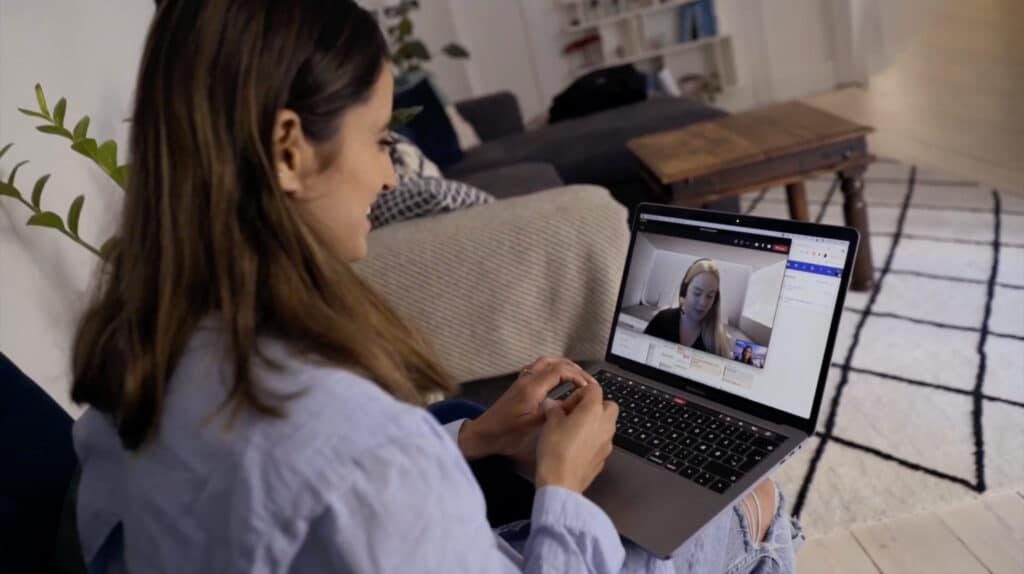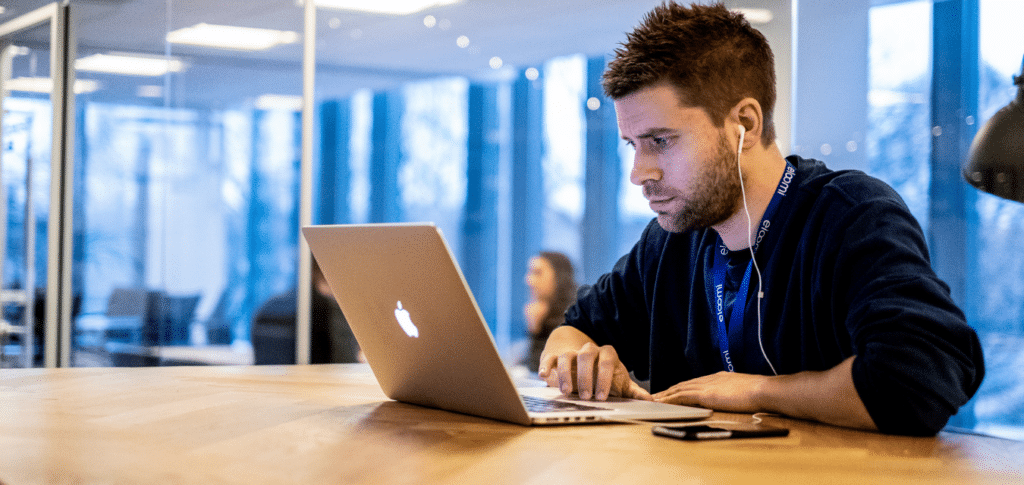Create your own inspiring work-from-home space
I want to begin this blog with something that could seem superfluous. Aesthetics. What does beauty have to do with remote work? Let me explain.
The environment around us and the space we work in have a huge influence over us, and that’s common knowledge. Colours have an impact on our feelings, and noise can affect our health in various ways. Working in a clean, organised, and bright place is fundamental for being productive and reducing stress.
So you should create an ambience where you can work with all the comfort and professional equipment needed.
A proper chair, for instance, is a necessary element as well as a larger screen. Ergonomics is probably one of the top terms of our time. Many companies help their employees find ways to get the best work set in their private homes by lending office equipment or finding special prices on their behalf.
Working remotely from a couch or a bed should only be for very rare occasions!
If you can, try to designate a room for working from home. It’s important to consider natural light exposure and how to avoid unwanted sounds. Take this opportunity to transform a room into a well-organised workspace and add a personal touch.
Plants and breathtaking photographs are always a good idea.

Remember that this is your space to work remotely in the best way, so don’t underestimate small details like decorations, nice background for video calls, and stationery supplies!
Here’s one more tip: you may find it inspiring and refreshing to change your workplace from time to time. Change the positioning of your furniture or try working from a different room to have a feeling of movement and diversification.
Work from home with style
There’s something I learned after a year and a half of working from home: get dressed for work. This doesn’t mean wearing your fanciest clothes in your apartment (unless you like it!). But don’t wear your half pyjamas and joggers every day!
Don’t get me wrong, being comfortable is important and, more importantly, being yourself.
My advice is to create a rotation of nice clothes and imagine your clothes as an extension of yourself.
A pro tip here is that wearing certain outfits will boost your self-confidence that you can undoubtedly use at important meetings or presentations.
Adapting to remote work also means keeping your morning routines. If makeup was your thing, don’t miss this step. If wearing a tie makes you feel ‘at work’, then go for it.
Remember that taking care of our looks creates a positive attitude and gives a balanced mindset.
This paragraph about personal appearance takes us to the next fundamental aspect of working from home. Video. Calls.
Remember that taking care of our looks creates a positive attitude and gives a balanced mindset.
Laura L, Learning Coordinator

The art of video calls
When I think of video conferencing, I consider it the most important of all the remote working activities.
I understand video calls can be difficult at times, but they take our human connection to the next level. Try to picture your workdays without interacting with your team. Think about all the missed opportunities to get a good laugh with your work buddy.
And, how many video calls have provided you with clarification or motivational thoughts?
Honestly, I can’t figure the number. But I know that every time I struggled with an assignment or forgot something, a call was vital. So, why do we need a camera on? I’ll tell you why.
Video calls require a certain focus from us because they are an all-encompassing experience. Besides, this is the precious human side that we shouldn’t lose while working remotely.
From my personal experience, video calls are the antidote to self-isolation. Especially the spontaneous ones, they often awaken me from my deep focus, offering me an unexpected break. My suggestion is to find a way to make video meetings more comfortable for you and others.
If you need more privacy, use a cool, predefined background. Have your headphones ready to get the most out of the experience and not be constantly distracted by something else.
Afraid of spending too much time with breaks and work socialisation? Schedule virtual coffee pauses or set walk-and-talk meetings!
One thing is certain; you should take advantage of the benefits of technology to get along with people while working remotely.
Also, have a conversation with your team about the timing of video calls. Some people would rather receive a message before a call, so it’s good to align with that.
If you don’t like being disturbed at a specific time of day, block it in your calendar.

Want to be more productive at home? Try these ideas!
You know what I’m talking about. Avoid distractions! How easy is that? The truth is that it’s not that simple to keep focus when working remotely.
First of all, being at home offers us many temptations to multitask. What about that full laundry bag? And the latest news? It’s hard to control all these inputs.
This is another valid reason to create a separate space while working at home.
Going into the digital space, you should do the same. Don’t save your personal accounts and favourite website bookmarks (including social media) on your work laptop.
You can also add blocking extensions to your browser and mobile phone. Alternatively, turn off all the unnecessary notifications and set the end time.
This strategy will help you achieve your task list much faster.
Keep in mind that you need to plan your personal time based on your team’s time to ensure high productivity and achieve common goals.
Laura L, Learning Coordinator

Another precious tip to eliminate distractions is to get a pair of noise-cancelling headphones. A high-quality headset will also give you a better experience while listening to music.
I suggest you look for deep focusing playlists or groundbreaking albums to nourish your soul and find your own rhythm when working from home!
Keep in mind that you need to plan your personal time based on your team’s time to ensure high productivity and achieve common goals.
How to master remote work planning
Among the challenges of remote work, productivity is the most debated. Several surveys like the one from Bloomberg have shown that people are much more productive when working from home, but they also increase their working hours, as reported by The Economist.
On the other hand, some collaborative tasks took more time due to a lack of immediate communication with coworkers. So, my advice is to find every productivity hack that works for you and adjust to the team’s needs.
But how to survive remote work and keep our life balanced?
Like many situations, planning ahead will save you time and money and get better outcomes (and fewer headaches!). It’s essential to plan with a goal-oriented mindset and a realistic view of deadlines.
Thus, when creating your to-do list, you know how to prioritise and communicate clearly with your colleagues and stakeholders.

Now that you no longer have external schedules for your daily commutes and office hours, you must create a program for yourself and be serious about it. Making a work from home plan includes short breaks, quiet time, lunch and learning slots to get motivated during the day. Don’t forget to add reminders for these breaks!
The most efficient way is to plan for the short and long term. You can use digital calendars, online platforms and, of course, a personal notebook to write down exciting ideas. What suits you best, it’s always the best choice.
One of the best suggestions I have learned from my work experience is to set expectations with managers or customers as soon as possible.
This step will lead you to set transparent performance appraisal goals and achievable deadlines.
I also find it extremely helpful to allocate specific time to deliver my assignments. For example, answering emails is one of the first things I do after my morning call. Then I can move on, and I don’t stress about some pending answers from my side.
You can even devote one day of the week to specific tasks, such as administration.
Save time to discuss with your colleagues the best way to work as a team and explore the best tools to support your shared workflow. As a manager, following this approach will help you promote asynchronous communication based on trust.
Employee engagement can be easily affected by working from home so remember to promote training and creative initiatives within your team.
You can easily start improving with an intuitive LMS.

Improve your soft skills while working from home
Working from home demands excellent communication skills, both written and spoken. It’s a terrific idea to improve your soft skills and become a professional communicator while remote working.
In our work-from-home routine, we should try to include any interactions we would have in the office. Note that I used the term ‘interactions’ to suggest something different from company meetings and announcements.
Take the time to share great ideas and laugh with your colleagues. Lightness does not imply superficiality. These moments create deeper connections with others and offer a relaxing moment.
Don’t underestimate the power of good humour for work motivation.
One good piece of advice is to share the lunch break with some of your peers.
At eloomi, for example, we often combine that with a chosen talking point, and it works marvellously!
By communicating openly, you naturally promote diversity and inclusion.
When working from home, it’s essential to nurture a feedback culture that could prevent potential struggles at an individual and collective level. It’s crucial to understand the different approaches and preferences to provide enough space for everyone. Inclusion starts when everyone is heard and valued equally.
The benefits of asynchronous communication
Another exciting thing about remote working is the possibility to enable asynchronous communication. This is basically another word for flexibility.
As an employee, you may find it extremely disruptive to be interrupted by different inputs in a short time. Or worse, you may feel under pressure to be constantly responsive and tight at your desk.
When you allow asynchronous communication, you give your employees a greater sense of trust while letting them focus properly and be more creative. Think about it. Working from home offers us the best chance to be productive and independent in our job.

Moreover, it gives us the freedom to make the best daily schedule based on different needs and work projects. This is one of the more exciting aspects of the future of work!
As I said before, expectations and deadlines must be set in advance to avoid unfortunate misunderstandings.
How about labelling urgent issues differently or using a specific channel? You can create different categories in your mailbox or create to-do lists according to different priorities and deadlines.
It’s all about agreeing on communication style and organisational methods!
If you want to get the most out of meetings, remember always to have an agenda for greater efficiency.
Also, have you ever found yourself thinking the following: “This meeting could have been an email”? Get inspired and become the expert in reducing non-essential meetings. I’m sure most of your colleagues are going to appreciate that.
Don’t forget to stretch your legs!
This last section is dedicated to wellbeing tips for working from home.
Once you have created a comfortable workspace, you should focus on looking after your physical and mental health.
What can you do?
- Get active – Walk your dog, run or take a short bike ride and remember to stretch your legs during work. Let the endorphins do their job for you!
- Disconnect – Once you have completed your tasks, leave the screens for a while, try cooking, painting or reading a book. Always make time for creativity.
- Relax your mind – Choose the best way to get rid of all your worries; a fun podcast or a meditation session can do wonders. And don’t forget to get enough sleep!
- Socialise – Having meaningful conversations offers an entirely different vibe to your day. Plan some time to have a chat or share a coffee with your coworkers.
- Stay inspired – Learning new skills can be truly satisfying, so remember to find exciting courses and stimulate your mind every day.
The article Continues below the infographic

Lately, I discovered an extra helpful tip that is to check my mental health level. It’s a smart idea to learn how to recognise signs of stress and prevent potential triggers. Remember that anxiety and depression can be hidden behind tiredness and increasing headaches.
As a manager, you can improve skills to praise and support your employees through meaningful feedback and milestone recognition. You can easily celebrate the journey and learning achievements with a gamified approach instead of just the results.
Leaders gain a better and genuine employee engagement by creating shared moments to reflect on different processes and personal issues.
You should ensure that your employees have all the necessary support, including mental health. It’s important to save time to listen to your remote employees’ needs and re-think the way of working. This gives you the best chance to improve internal dynamics and enhance teamwork.
Start improving today!
Now that you got all the tips and good practices for working from home, be sure to find your way to improve motivation and productivity.
In summary, here are the three key takeaways:
- Plan your workday and log off properly afterwards.
- Communicate and save time for socialisation.
- Take care of yourself, both physically and mentally.
The extra tips to improve remote work quality are finding a designated workspace and allocating time for learning.
Working from home is the future of work; that’s a statement. And it goes without saying that being outside the office has its own pros and cons. Fortunately, after more than a year of experiencing remote working, we can define the best tools to be productive and fully satisfied.






